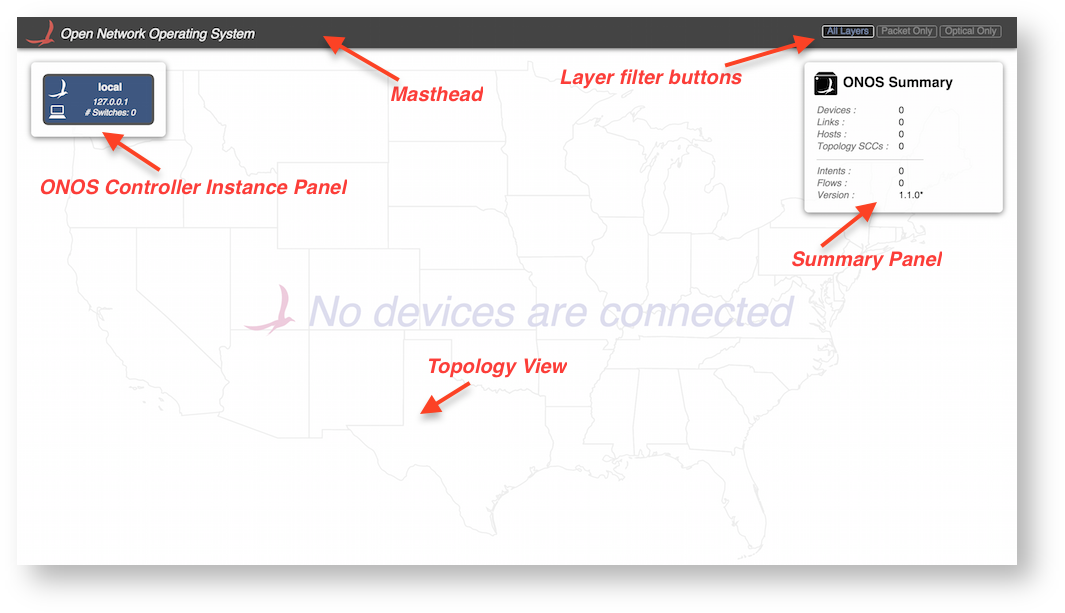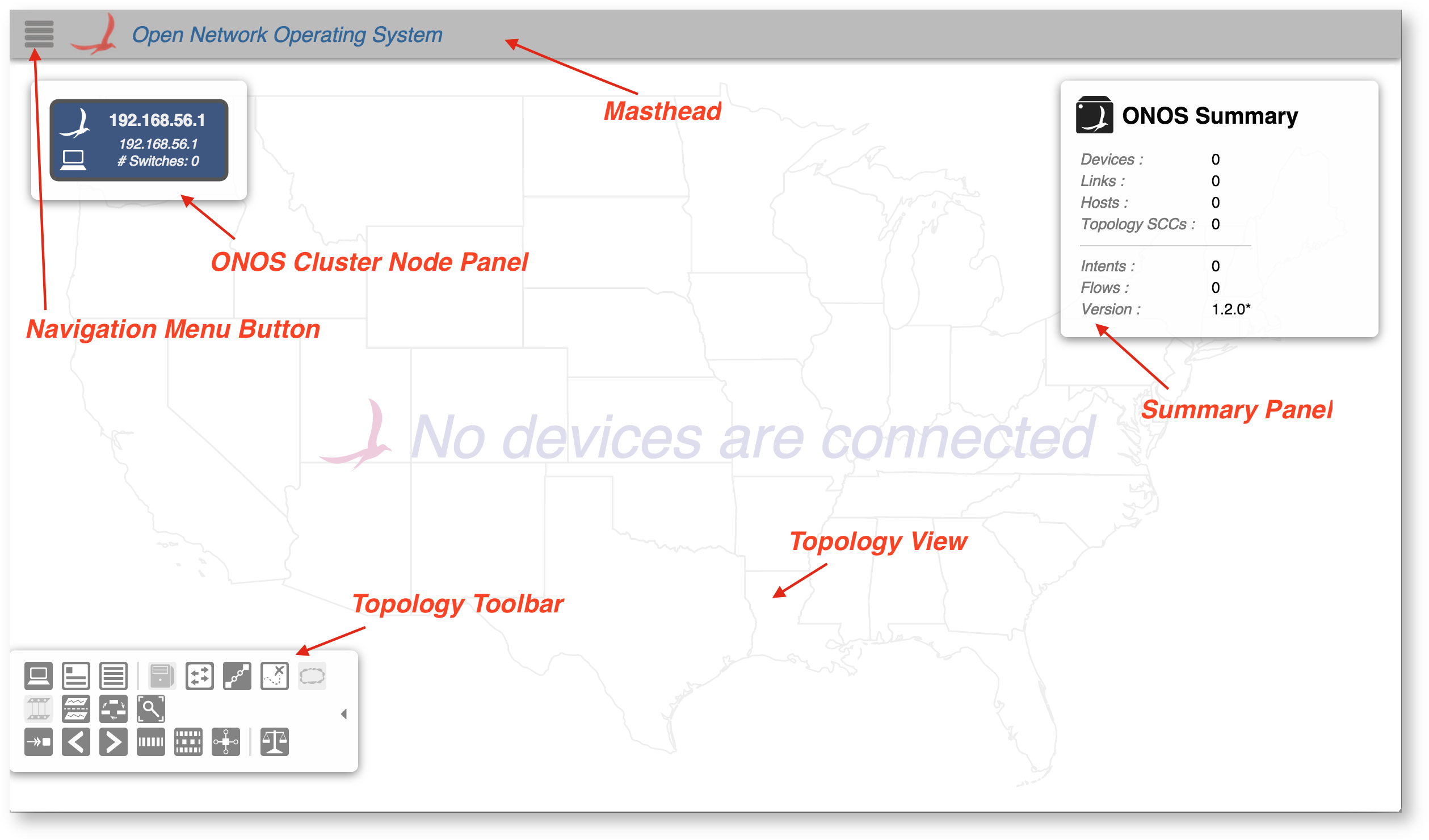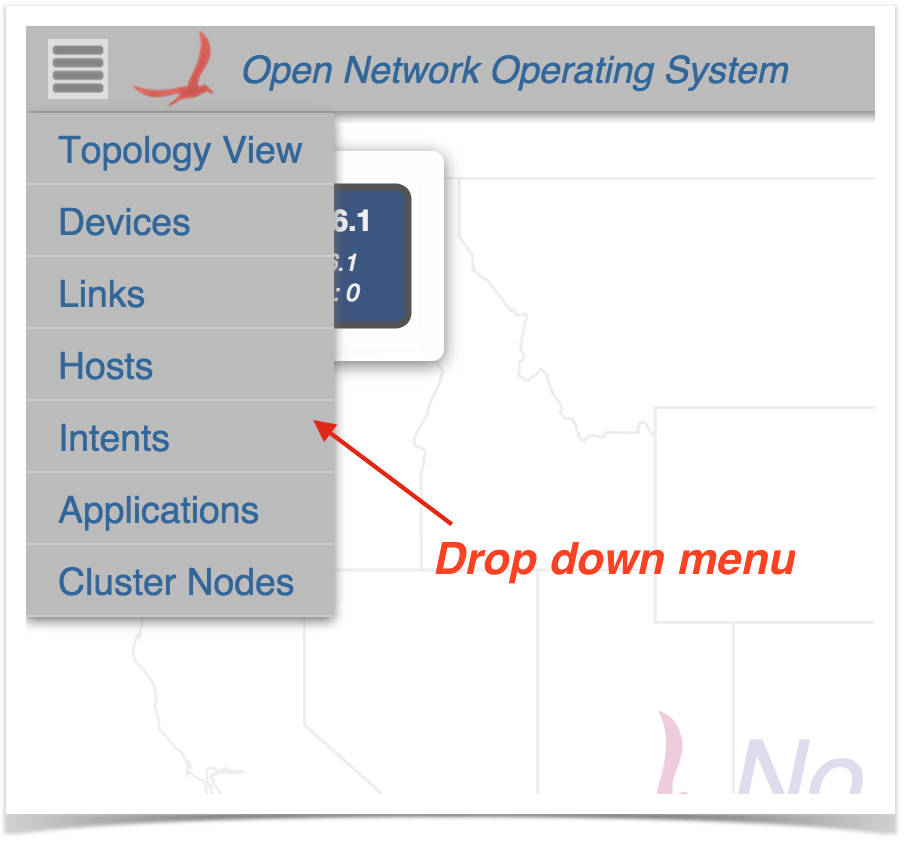...
On launching the GUI you should see a screen that looks something like this:
The dark gray bar at the top is the Masthead, which provides a location for general GUI controls. In In the current version (1.12.0 "BlackbirdCardinal") this is where the "topology layer filter" radio buttons are placed. the masthead contains:
- the Navigation Menu Button
(In future versions, this the masthead will be where session controls – include session controls, such as user ID, user preferences, logout etc. -- will be located.)
The remainder of the screen is the "view" – in this case the "Topology View" which gives a , which defaults to the Topology View when the GUI is first loaded – a cluster-wide view of the network topology.The
- The ONOS
...
- Cluster Node Panel
...
- indicates the controllers in the cluster.
...
- The Summary Panel
...
- gives a brief summary of properties of the network topology.
GUI Navigation
- The Topology Toolbar provides pushbutton / togglebutton actions to interact with the topology view.
For more detailed information about this view, see the Topology View page.
Navigating from one view to another is done by opening the navigation pane and clicking on a link ("nav item"). As of the current release (1.1.0 "Blackbird") this feature is still under development.
GUI Views
The GUI is capable of supporting multiple views and as new views are added to the base release, they will be documented here.
NOTE: The capability of adding views to the GUI dynamically at run-time is being developed. This will allow, for example, an ONOS App developer to create GUI content that works specifically with his application. The content will be dynamically injected into the GUI when the app is installed, and automatically removed from the GUI when the app is uninstalled. For more details on this feature, see (TBD).
The views included with the base release are:
| View | Description |
|---|---|
| Topology View |
...
| The Topology View |
...
| provides an interactive visualization of the network topology, including an indication of which devices (switches) are mastered by each ONOS controller instance. |
...
| Devices |
...
| The Device View* provides a top level listing of the devices in the network. |
...
| Links | The Link View* provides a top level listing of all the links in the network. |
...
| Hosts |
...
| The Host View* provides a top level listing of all the hosts in the network. |
...
| Intents | The Intent View* provides a top level listing of all the intents in the network. |
...
| Applications |
...
| The Application View* provides a listing of applications installed, as well as interaction with them on the network. |
| Cluster |
...
| Nodes | The Cluster Node View* provides a top level listing of all the cluster nodes, or instances, in the network. |
...
The Intent Performance View provides a real-time graph of intent performance.
*Tabular View: The GUI has multiple "tabular views" that are similar in look and interaction, but display different information. For a general overview of tabular usage, see the Tabular View page. For specifics on each view, see follow the links in the above table.
Release Notes
This section provides a reverse-chronological listing of changes to the GUI for each release.
Cardinal – 1.2.0
- Websocket mechanism promoted to be framework-wide; a shared resource amongst the views.
- More tabular views added:
- Links, Hosts, Intents, Applications, Cluster Nodes.
- On the topology view, links are now selectable.
- < ... More notes to come ... >
- Note that the legacy (Avocet) GUI has been deprecated, and that the (Angular-based) GUI loads by default.
Blackbird – 1.1.0
- GUI Framework migrated to use AngularJS.
- View-agnostic features refactored as Angular Services.
- Topology View refactored to be an Angular module.
- Topology source code broken out into multiple source files.
- Port Highlighting on links added.
- Device View added.
- Implemented as a simple table for now; one device per row, sortable by column header clicks.
- Sample View added.
- Skeletal example code.
- Light and Dark themes fully implemented.
- Press the 'T' key to toggle theme.
- Beginnings of UIExtension mechanism implemented
- Over future releases, this will facilitate the ability of Apps to inject their own content into the GUI.
- Over future releases, this will facilitate the ability of Apps to inject their own content into the GUI.
- Note that the new (Angular-based) GUI currently co-exists with the old (Avocet) GUI.
- By default, the Avocet GUI is launched; the base URL http://localhost:8181/onos/ui is mapped to http://localhost:8181/onos/ui/legacy/index.html#topo.
- The new Angular-based GUI can be launched by manually adjusting the URL to be: http://localhost:8181/onos/ui/index.html#topo, (that is, remove "legacy/").
...


